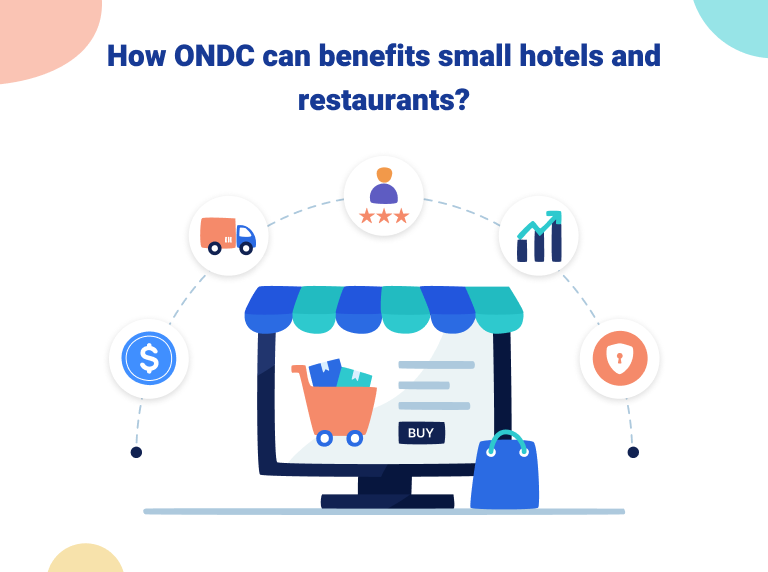Open Network for Digital Commerce (ONDC) has appeared as a big solution that offers opportunities for growth, efficiency, and customer experiences. In this article, we will find how ONDC can benefit small hotels and restaurants and contribute towards their growth.
What is ONDC?
ONDC stands for the Open Network for Digital Commerce. It is an open network that can transform e-commerce and online shopping.
Imagine Amazon and Flipkart, Swiggy and Zomato, Paytm, and even Uber all on just one app. That is ONDC, a single app for everything.
On ONDC any buyer can connect with the seller and customers can get the best deal and prices. More choices mean more power in the hands of the consumer.
The customer compares Amazon and Flipkart prices on one page and prices of Zomato and Swiggy on another page. This results in platforms competing with one another which eliminates high commission and hidden charges.
When the customer gets to compare Amazon and Flipkart prices on one page and Zomato & Swiggy on one page Uber and Ola on another page it will automatically lead to platforms competing for the best price eliminating high commissions and hidden charges.

What is the need for ONDC?
So to understand the true purpose behind ONDC let’s look at what ONDC will do for small hoteliers and restaurant owners.
Among thousands of food delivery apps in India, Zomato and Swiggy control over 60% of the market. These apps are on closed networks that keep out several small restaurants which impacts their revenue.
Many restaurant owners have filed complaints against these delivery apps accusing them of monopolizing the market. They can impose the pricing terms on partner restaurants. This is one of the major challenges faced by many small hotel owners and restaurant owners.
How do Ecommerce based food delivery companies work?
To understand this let’s break down how exactly these e-commerce-based online platforms make money.
There are two basic models e-commerce platforms in India follow
- Marketplace model
- Inventory model.
Marketplace Model
In Marketplace the website or app only acts like a platform that connects the buyer and seller and then they take a percentage cut when the particular product is sold.
Inventory Model
In the inventory model where the platform buys directly from the seller in bulk using its bargaining power
In a simple inventory model, the platform buys products from the seller in large quantities at a low price, using its ability to negotiate, and then sells them at a higher price to make more profit.
Also, these platforms can then push up commodities by sellers whom they’ve bought in bulk from and deliver exclusive deals and offers. Thus pushing out other sellers.
Moreover, these platforms can still limit their search results to specific hotel or restaurant chains that have tied up with the platforms. This means these chains will on top of the search results, give maximum visibility to their favored sellers where they get maximum margins.
ONDC for Hotels and Restaurants
As ONDC is an open network, it will show you results across e-commerce platforms. This can help hoteliers in multiple ways:
- Consumers end up discovering a local restaurant near them that could bring them what they need faster and cheaper
- This in fact gives small hotels or restaurants to sell their product fairly with no platform biases.
- In case a seller app can’t deliver to your address or suppose Zomato is charging you too heavily for deliveries. You can actually choose another delivery partner from the ONDC pool. So, you can order on one app and your product will be delivered from another app.

How to use ONDC
Well, unlike Swiggy and Zomato, ONDC is not an app. To use ONDC you have to download its Network participant apps like Paytm, PhonePe, and others. Here, you can search for your product like food or any other commodities. ONDC acts as a middleman that connects buyers and sellers.
For eg: In the app, you can order food from both small local restaurants or well-known food chains. ONDC brings together these different restaurants, giving customers more choices, and competitive prices while encouraging healthy competition.
Challenges faced by ONDC
Customer Service
All these apps have built their brand trust over a long period. If you have a problem like your order is not completed, if your order is canceled, or if a wrong order comes, then you can call customer service.
But the ONDC’s platforms have to be built from scratch, they have to provide a very good reason or big incentive to customers so that they can switch to this service. Also, they need to improve their customer service at the initial stage to keep their existing customers.
Sustainability
Another problem for ONDC is sustainability. How will ONDC sustain itself? Even after taking a margin of 25-30%, are these players still not profitable?
So, how will ONDC’s platforms become profitable? This means that if they are not profitable, then all these buyer apps will spend a lot in marketing to attract new customers.
So these apps will raise a lot of funding, and will onboard users, and will keep on doing deep discounting.
And on the other hand, ONDC is also able to do deep discounting to attract users today, because they have some funds. But for how long?
The other big question is whether the technology will be good enough to compete with the current e-commerce major e-commerce giants.
Conclusion
ONDC has a lot of potential to break the duopoly of these food apps. Of course, it was made with the initiative of the government to promote local restaurants. Currently, the ONDC has rolled out in many cities but it is still too early to say whether will it encourage healthy competition and benefit small-scale hotels and restaurants.
Get In Touch
I hope you liked my article on ONDC and how can it impact small hotels and restaurants.
If you are a hotelier looking for a solution to manage your hotel efficiently, try QloApps- A free Hotel Reservation System.
Also, if you want to share your thoughts or ask any queries, please connect with us on our QloApps forum.

Be the first to comment.